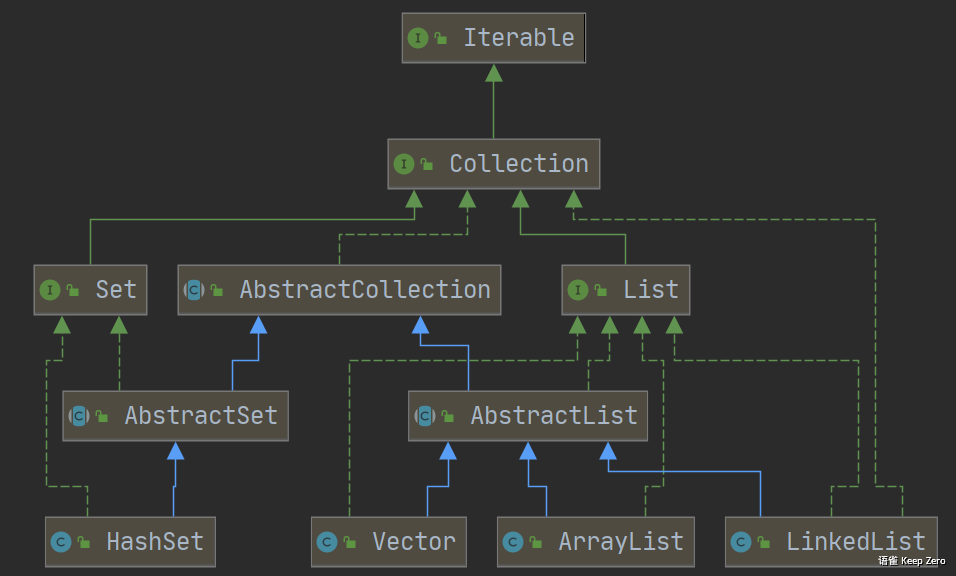类关系图

功能介绍
包路径:java.util
功能描述:Set 继承自Collection接口,只是行为上不同,Set 不保存重复的元素**。Set集合的实现类可说是基于Map集合去写的。通过内部封装Map集合来实现的比如HashSet内部封装了HashMap
Set 接口存储一组唯一,无序的对象。
特点:插入无序,不可指定位置访问。
源码解析
Set
package java.util;/**** @param <E> the type of elements maintained by this set** @author Josh Bloch* @author Neal Gafter* @see Collection* @see List* @see SortedSet* @see HashSet* @see TreeSet* @see AbstractSet* @see Collections#singleton(java.lang.Object)* @see Collections#EMPTY_SET* @since 1.2*/public interface Set<E> extends Collection<E> {// Query Operations/*** 获取集合元素数量* @return the number of elements in this set (its cardinality)*/int size();/*** 判断集合是否为空* @return <tt>true</tt> if this set contains no elements*/boolean isEmpty();/*** 判断集合内是否存在目标元素* @param o element whose presence in this set is to be tested* @return <tt>true</tt> if this set contains the specified element*/boolean contains(Object o);/*** 返回迭代器* @return an iterator over the elements in this set*/Iterator<E> iterator();/*** 将集合转为数组返回* @return an array containing all the elements in this set*/Object[] toArray();/*** 将集合转为目标类型的数组返回* @param a the array into which the elements of this set are to be* stored, if it is big enough; otherwise, a new array of the same* runtime type is allocated for this purpose.* @return an array containing all the elements in this set*/<T> T[] toArray(T[] a);// Modification Operations/*** 添加元素* @param e element to be added to this set* @return <tt>true</tt> if this set did not already contain the specified* element*/boolean add(E e);/*** 从集合中移除元素* @param o object to be removed from this set, if present* @return <tt>true</tt> if this set contained the specified element*/boolean remove(Object o);// Bulk Operations/*** 判断是否存在传入集合的所有元素(交集)* @param c collection to be checked for containment in this set* @return <tt>true</tt> if this set contains all of the elements of the* specified collection*/boolean containsAll(Collection<?> c);/*** 添加传入集合的所有元素* @param c collection containing elements to be added to this set* @return <tt>true</tt> if this set changed as a result of the call* @see #add(Object)*/boolean addAll(Collection<? extends E> c);/*** 仅保留传入集合里存在的元素(求交集)* @param c collection containing elements to be retained in this set* @return <tt>true</tt> if this set changed as a result of the call* @see #remove(Object)*/boolean retainAll(Collection<?> c);/*** 仅移除传入集合的所有元素* @param c collection containing elements to be removed from this set* @return <tt>true</tt> if this set changed as a result of the call* @see #remove(Object)* @see #contains(Object)*/boolean removeAll(Collection<?> c);/*** 清空集合*/void clear();// Comparison and hashing/*** 判断集合是否相等(集合内所有元素相等则为相等)* @param o object to be compared for equality with this set* @return <tt>true</tt> if the specified object is equal to this set*/boolean equals(Object o);/**** @return the hash code value for this set* @see Object#equals(Object)* @see Set#equals(Object)*/int hashCode();/*** 返回切割器* @return a {@code Spliterator} over the elements in this set* @since 1.8*/@Overridedefault Spliterator<E> spliterator() {return Spliterators.spliterator(this, Spliterator.DISTINCT);}}
AbstractSet
AbstractSet是一个抽象类,实现了Set接口,同时继承了AbstractCollection抽象类
package java.util;/**** @author Josh Bloch* @author Neal Gafter* @see Collection* @see AbstractCollection* @see Set* @since 1.2*/public abstract class AbstractSet<E> extends AbstractCollection<E> implements Set<E> {/*** Sole constructor. (For invocation by subclass constructors, typically* implicit.)*/protected AbstractSet() {}// Comparison and hashing/*** 比较两个集合是否相等* @param o object to be compared for equality with this set* @return <tt>true</tt> if the specified object is equal to this set*/public boolean equals(Object o) {if (o == this)return true;if (!(o instanceof Set))return false;Collection<?> c = (Collection<?>) o;if (c.size() != size())return false;try {// 是否全部存在return containsAll(c);} catch (ClassCastException unused) {return false;} catch (NullPointerException unused) {return false;}}/**** @return the hash code value for this set* @see Object#equals(Object)* @see Set#equals(Object)*/public int hashCode() {int h = 0;Iterator<E> i = iterator();while (i.hasNext()) {E obj = i.next();if (obj != null)h += obj.hashCode();}return h;}/*** 从当前集合中移除传入集合包含的所有元素* @param c collection containing elements to be removed from this set* @return <tt>true</tt> if this set changed as a result of the call* @see #remove(Object)* @see #contains(Object)*/public boolean removeAll(Collection<?> c) {Objects.requireNonNull(c);boolean modified = false;// 如果当前集合元素比传入集合元素多if (size() > c.size()) {// 迭代传入集合并从当前集合移除for (Iterator<?> i = c.iterator(); i.hasNext(); )modified |= remove(i.next());} else {// 迭代当前集合for (Iterator<?> i = iterator(); i.hasNext(); ) {if (c.contains(i.next())) {i.remove();modified = true;}}}return modified;}}
简单使用
public class SetCode {public static void main(String[] args) {commonExample();}public static void commonExample(){Set<Integer> mySet = new HashSet<>();for(int i=0;i<20;i++){mySet.add(i);}System.out.println("mySet = "+mySet);System.out.println("mySet.size() = "+mySet.size());Set<Integer> subSet = new HashSet<>();for(int i=0;i<10;i++){subSet.add(i);}System.out.println("subSet = "+subSet);System.out.println("mySet.containsAll(subSet) = "+mySet.containsAll(subSet));mySet.removeAll(subSet);System.out.println("mySet = "+mySet);}}
输出:
mySet = [0, 1, 2, 3, 4, 5, 6, 7, 8, 9, 10, 11, 12, 13, 14, 15, 16, 17, 18, 19]
mySet.size() = 20
subSet = [0, 1, 2, 3, 4, 5, 6, 7, 8, 9]
mySet.containsAll(subSet) = true
mySet = [10, 11, 12, 13, 14, 15, 16, 17, 18, 19]
总结
1、Set 继承自Collection接口,只是行为上不同,Set 不保存重复的元素。Set集合的实现类可说是基于Map集合去写的。通过内部封装Map集合来实现的比如HashSet内部封装了HashMap
2、Set 接口存储一组唯一,无序的对象。
3、Set插入无序,不可指定位置访问。
思考
Set和List的区别
- Set 接口实例存储的是无序的,不重复的数据。List 接口实例存储的是有序的,可以重复的元素。
- Set 接口实例存储的是无序的,不重复的数据。List 接口实例存储的是有序的,可以重复的元素。
- Set检索效率低下,删除和插入效率高,插入和删除不会引起元素位置改变 <实现类有HashSet,TreeSet>。
- Set检索效率低下,删除和插入效率高,插入和删除不会引起元素位置改变 <实现类有HashSet,TreeSet>。
- List和数组类似,可以动态增长,根据实际存储的数据的长度自动增长List的长度。查找元素效率高,插入删除效率低,因为会引起其他元素位置改变 <实现类有ArrayList,LinkedList,Vector> 。
- List和数组类似,可以动态增长,根据实际存储的数据的长度自动增长List的长度。查找元素效率高,插入删除效率低,因为会引起其他元素位置改变 <实现类有ArrayList,LinkedList,Vector> 。

